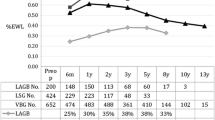Background: In the non-superobese population, consensus is currently unavailable in bariatric surgery. We report the results of a prospective comparison of vertical banded gastroplasty (VBG) and Roux-en-Y gastric bypass (RYGBP) in a non-superobese population. Methods: From 1994 to 2000, 179 patients with clinically severe obesity underwent various surgical procedures in our department. During this time a prospective study was undertaken in order to compare VBG with RYGBP in morbidly obese patients with a BMI <50 kg/m2. Based on specific criteria including eating behavior, 68 patients were selected to undergo RYGBP and 35 VBG. All patients have undergone complete follow-up evaluation at 1, 3, 6, and 12 months postoperatively and every year thereafter. Results: All patients have now completed their 5th postoperative year. Mean follow-up period to date is 96.5±12.2 months for VBG and 67.6±11.3 months for RYGBP. 3 patients (8.6%) in the VBG group and 9 patients (13.2%) in the RYGBP group are lost to follow-up. Mean excess weight loss (EWL) was always better in the RYGBP group (P=0.0013). The percentage of failure, defined as EWL <25%, was not significantly different between the two procedures. No statistically significant differences were observed between the 2 groups in the total number of non-metabolic complications, and the only statistically significant difference observed in metabolic complications was vitamin B12 deficiency after RYGBP. Frequency of vomiting was significantly less and quality of eating significantly better in RYGBP than in VBG patients. Conclusion: This prospective long-term study, with nearly complete follow-up, suggests that in the non-superobese population, preoperative eating habits may play a role in choosing the most appropriate bariatric operation for each patient. Although RYGBP is associated with better mean weight loss outcomes, the percentage of patients who achieved and maintained ≥50% EWL after VBG in this pre-selected patient population was not significantly different. Each type of operation has advantages and disadvantages, and, if properly chosen, a purely restrictive procedure can be successful for some patients. Therefore, it can be said that the decision regarding which bariatric procedure to perform in non-superobese patients must be based on in-depth preoperative evaluation as well as the patients' own preferences and outcome expectations.
Similar content being viewed by others
Author information
Authors and Affiliations
Rights and permissions
About this article
Cite this article
Kalfarentzos, F., Skroubis, G., Kehagias, I. et al. A Prospective Comparison of Vertical Banded Gastroplasty and Roux-en-Y Gastric Bypass in a Non-Superobese Population. OBES SURG 16, 151–158 (2006). https://doi.org/10.1381/096089206775565096
Published:
Issue Date:
DOI: https://doi.org/10.1381/096089206775565096



